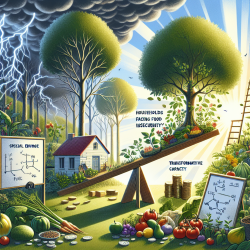Introduction
In the face of financial shocks, many households find themselves grappling with food insecurity. The recent research article, "Development of three new multidimensional measures to assess household food insecurity resilience in the United States," sheds light on innovative ways to measure and enhance household resilience. As practitioners, understanding and implementing these findings can significantly impact the communities we serve.
Understanding Household Resilience
The study introduces three key constructs to assess household resilience: Absorptive Capacity, Adaptive Capacity, and Transformative Capacity. Each of these measures provides a unique lens through which we can evaluate and support households facing financial challenges.
- Absorptive Capacity: This refers to a household's ability to minimize exposure to shocks and recover quickly when they occur. It involves having stable income, housing, and financial wellbeing.
- Adaptive Capacity: This is the ability to make informed choices about alternative livelihood strategies in response to changing conditions. It includes financial self-efficacy, knowledge, and social support.
- Transformative Capacity: This involves the conditions necessary for long-term resilience, such as access to community resources, opportunities, and a positive financial outlook.
Implementing the Research Findings
Practitioners can utilize these measures to conduct needs assessments, evaluate programs, and develop tailored interventions. Here are some practical steps:
- Conduct Comprehensive Assessments: Use the measures to assess the current resilience capacities of households. This will help identify areas where support is needed most.
- Develop Targeted Interventions: Based on the assessment, create interventions that address specific barriers identified, such as job barriers or access to community resources.
- Utilize Brief Screeners: In settings where time is limited, use the brief screener versions of the measures to quickly identify households at risk of low resilience.
- Promote Community Engagement: Encourage households to engage with community resources and support systems to enhance their transformative capacity.
Encouraging Further Research
While the study provides a robust framework, further research is needed to confirm these findings in diverse populations and settings. Practitioners are encouraged to contribute to this growing body of knowledge by conducting studies in their own communities.
Conclusion
By understanding and applying these new measures of household resilience, practitioners can play a crucial role in reducing food insecurity and building stronger, more resilient communities. The potential applications of these tools are vast, ranging from program evaluation to public health surveillance.
To read the original research paper, please follow this link: Development of three new multidimensional measures to assess household food insecurity resilience in the United States.










